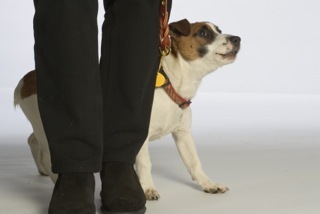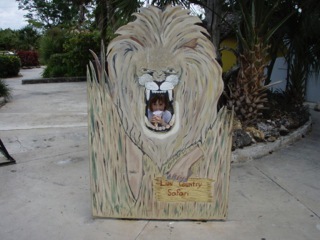In my last blog post, "10 Ways To Avoid A Dog Bite," I began a series on how and/or your children can avoid being bitten by a dog. I listed 10 steps to stay safe and explained the first step regarding staring.
In today's release, I'm going to take you inside the mind of a dog who uses aggression and provide a more lengthy explanation of steps two and three:
Step 2 -- Understand a Breed's Mentality and
Step 3 -- Don't Take it Personally.
But first, the secret...
Aggression as it used to describe a dog's behavior, is not an adjective, it's a verb.
A dog uses aggression, he is not aggressive.
It's a small statement but has tremendous implications.
As an adjective, a word like "aggression" or its synonym, "dominance", would be used to describe a dog in the following ways:
-"My dog is really dominant." or
-"She's an aggressive dog."
But here is what good professionals know, and what I want to share with you today. There isn't a dog on the planet who is aggressive all the time. A dog uses aggression, he isn't aggressive.
Confused? Let me give you two examples using people.
Meet Pete the marine. In Kuwait, he was awarded the Purple Heart medal of honor for bravery on the field. He used all his strength, cunning, and determination to overcome his captives. He dominated and used his skills -- his aggression -- to save five other American prisoners. He only killed when he had no other choice.
Personally, I don't know that Pete. I know the Pete at the coffee shop who holds the door for me; the Pete who plays with my kids at church; the Pete who comes to our holiday party and plays with my dogs. I have never seen the aggressive Pete, but I've seen his medal, so I know it's true.
Next, meet my five-year-old son. Most of the time, he's a cheerful kid. I have few complaints. Over the holiday my husband and I bought him the newest Lego Star Wars droid fighter, ignoring the "for 8 - 14-year-olds" label. Even when I saw it I thought, "Oh, he's so clever, he'll be able to do it."
His fleeting joy at receiving the present was replaced first by a focus to build it and then by shouts of frustration. Apparently, it was broken.
"This is a stupid Lego!" he screamed. "God should have never built this Lego!"
Now, another kid would have asked for help or quit and moved on, but not my boy. He pounded the table with clenched fists and took it up with God.
So some dogs, like some people, use aggression to control intense feelings of frustration or fear. Some dogs, but not all dogs. A dog might choose to piddle in fear, rather than lash out with their mouth, while other dogs simply choose to leave the situation entirely.
My weekly roster is full of speaking dog owners down off the ledge, either face-to-face or over the phone, and fielding concerns like:
"My dog was in a fight with another dog, and we have a baby at home. I'm frightened he'll attack the baby."
"My dog growled at the veterinarian. He says we have a dominant dog, but our dog is so sweet at home."
"My dog bit the delivery guy, but otherwise he's so sweet. I don't get it."
As it is my profession, I help my clients to better understand their dog's behavior so that they can help their dog to manage his/her intense feelings. In each case there is a trigger -- another aggressive dog, an intrusive procedure by a virtual stranger/veterinarian, or a stranger approaching the den. None of these dogs are aggressive all of the time.
More correct ways to discuss a dog who shows aggression would sound like this:
"My dog uses aggression when _____ (people come to the door, in the yard, with other dogs)"
or "My dog shows dominance over his ______ (food bowl, sleeping area, bones)."
Neither statement pigeonholes the dog as "dangerous" though each provides useful information about the dog's behavior in certain situations. An outsider would be less afraid of the animal, though more cautious to avoid situations that would trigger the dog's stress.
When meeting a dog, try to determine if there are situations you should avoid, especially if you'll be spending any time with the dog.
Now for steps two and three. In last week's blog post you learned not to stare or stare back at a dog who is watching you. Remember: most dogs view penetrating eye contact as confrontational or predatory. Here are steps two and three:
Step Two -- Understand a Breed's Mentality
Dogs are undoubtedly the most diverse species on Earth. There are dogs that weigh less than five pounds and others that weigh over 100 pounds. There are white dogs and black dogs; fluffy and smooth-coated varieties; dogs with pushed-in snouts and dogs with noses that point like arrows. The difference in physical traits is tangible, but these differences go more than skin-deep. The genetics of dogs have been tinkered with over the millennium, creating breeds to fill a variety of roles. There are breeds designed to herd sheep, pull sleds and protect homes and farms. Other dogs have been modified to retrieve game and hunt vermin or have been bred down to serve as companions. Learn about different dog breeds and avoid those bred to serve protective roles. These dogs see all strangers as a potential threat. Though there are exceptions, it is better to play by the rules.
Step Three -- Don't take it personally.
I learned a valuable lesson growing up: some people are going to like me, some people won't, and there's not a lot I can do about it. The same can be said for dogs. No matter how much you love dogs, some are going to reflect your enthusiasm and others won't.
How can you tell if a dog is friendly or not? Here's a trick I teach both children and adults. When near an unfamiliar dog, extend your hand towards the dog's face with your palm facing up. Keep your hand 6-12" from the dog's snout. If the dog steps forward to sniff it and wags his tail, you're in. If he turns his head, stares at you or backs away, leave him alone.
If the dog could talk he might tell you he had a bad experience with someone who looked like you or wore your cologne. The dog might have a bellyache or be having a bad day. Regardless, if the dog doesn't want to connect, respect him and move on. No harm, no growl.
Stay tuned for steps four and five in the coming weeks. And remember -- aggression doesn't have to be a four-letter word!

